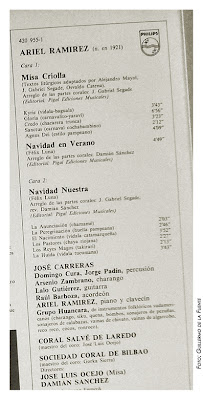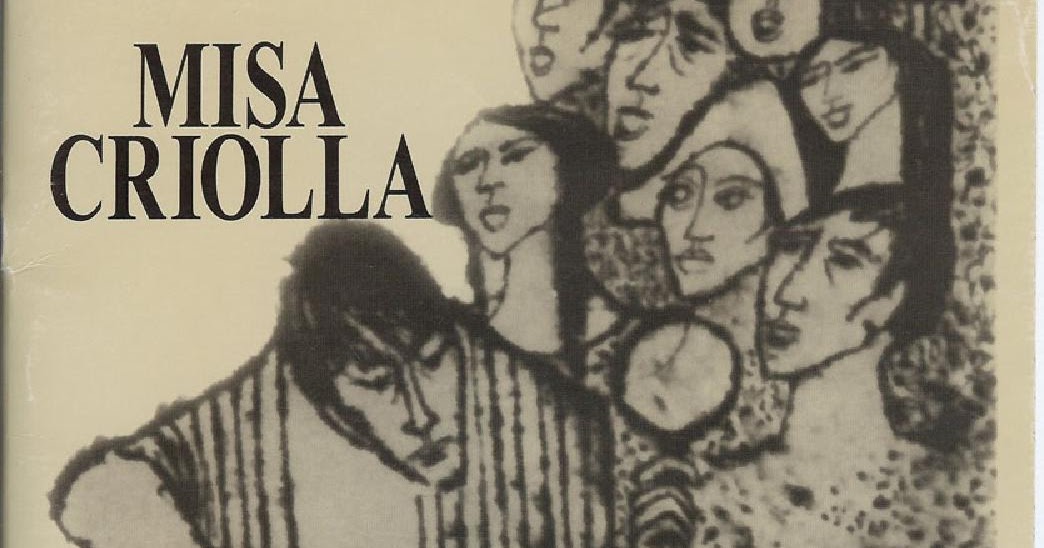Ramirez/ Misa criolla: messa con strumenti e ritmi indigeni, testo in spagnolo. Kyrie, Gloria, Credo, Sanctus, Agnus Dei, (Mp3); Misa Criolla: spartito SATB.
Choose where you want to share:
Link to this page
Embed on your site
The score can be downloaded in the format of your preference:

MuseScore
Open in MuseScore
View and print
MusicXML
Open in various software
MIDI
Open in editors and sequencers
MP3
Listen to this score
Your download has started. Having troubles downloading? Try again
JanBrugge worked hard on this score.
Want to give something back?
Give a small token of appreciation!
Your download has started. Having troubles downloading? Try again
More of this, please?
Follow to get notified when JanBrugge has uploaded new scores.
Or give a reward instead
Uploaded on Sep 15, 2012
Composed by Ariel Ramirez.
the Kyrie (A cappella) from his Misa Criolla
| Pages | 9 |
| Duration | 01:56 |
| Measures | 71 |
| Key signature | natural |
| Parts | 7 |
| Part names | |
| Privacy | Everyone can see this score |
| License | None (All rights reserved) |
Your comment
Comments
Ariel Ramírez in 1968 | |
| Background information | |
|---|---|
| Born | 4 September 1921 Santa Fe, Argentina |
| Died | 18 February 2010 (aged 88) Monte Grande, Buenos Aires, Argentina |
| Occupation(s) | Composer, pianist, music director |
| Instruments | Piano, vocals |
Ariel Ramírez (4 September 1921 – 18 February 2010) was an Argentine composer, pianist and music director. He was considered 'a chief exponent of Argentine folk music' and noted for his 'iconic' musical compositions.[1]
Ramírez is known primarily for his Misa Criolla (1964).[2][3] It allowed him to travel around Europe and Latin America to build his reputation.[3] However, he wrote more than 300 compositions during his career, and sold millions of albums.[4][5]
- 2Compositions
Biography[edit]
Ariel Ramírez was born in Santa Fe, Argentina.[5] His father, who was from Spain and immigrated to Argentina, was a teacher and it had been thought Ramírez would also pursue this career path but the job lasted for just two days due to 'discipline problems'.[5] He pursued initially tango before switching to Argentine folklore.[5] He began his piano studies in Santa Fe, and soon became fascinated with the music of the gauchos and creoles in the mountains. He continued his studies in Córdoba, where he met the great Argentinian folk singer and songwriter Atahualpa Yupanqui and was influenced by him.[3]
Following a suggestion from Yupanqui, he visited the northeastern part of Argentina, and deepened his research into the traditional rhythms of South America. He spent time in Mendoza and Buenos Aires.[3] At the same time continuing his academic studies as a composer at the National Conservatory of Music, in Buenos Aires.[3] He made his first recording in 1946, with RCA; he made twenty records with that label until 1956.[3]Plácido Domingo, José Carreras and Mercedes Sosa are some of the artists to have recorded his work.[2] He was also associated with Miguel Brascó and Félix Luna.[4]
Ramírez went on to study classical music in Madrid, Rome and mainly in Vienna, from 1950 to 1954. Back in Argentina, he collected over 400 folk and country songs and popular songs and founded the Compañía de Folklore Ariel Ramírez.[6]
Ramírez had two daughters, Mariana and Laura, and a son, Facundo.[7] (NB: The Washington Post reported in error that he had two sons.)[5] He married musicologist Norma Inés Cuello de Ramírez.[8][9]
Compositions[edit]
In 1964, the Ramírez composition Misa Criolla marked the beginning of a period of high musical productivity for the composer, which also heralded the premieres of the works Navidad Nuestra and La Peregrinación (both 1964); Los Caudillos (1965); Mujeres Argentinas (1969), and Alfonsina y el Mar (1969), all produced in collaboration with writer Félix Luna. Misa Criolla and Alfonsina y el Mar are probably his best-known compositions.
Misa Criolla[edit]
Misa Criolla Partitura
Misa Criolla was one of the first masses not in Latin shortly after the Second Vatican Council permitted use of the vernacular in Catholic churches.[2][5]The Washington Post wrote that the Misa Criolla is 'widely regarded as a stunning artistic achievement, [that] combined Spanish text with indigenous instruments and rhythms'.[5] It led to album sales numbering in the millions internationally.[5] Ramírez once told The Jerusalem Post how Misa Criolla was inspired by a visit to Germany after World War II.[5] While there, he had an encounter with two of 5 sisters (siblings, not nuns), who had regularly risked their lives bringing food to Naziprisoners in their neighbourhood, which led him to consider writing 'a spiritual piece'. This would eventually become the Misa Criolla.[5]
The Misa—a 16-minute Mass for either male or female soloists, chorus, and traditional instruments—is based on folk genres such as chacarera, carnavalito, and estilo pampeano, with Andean influences and instruments. Ramírez wrote the piece from 1963 to 1964, and it was recorded in 1965[10] by Philips Records, directed by Ramírez himself with Los Fronterizos as featured performers (Philips 820-39 LP, including Navidad Nuestra, remastered in 1994 and released by Philips as CD 526 155). It was not publicly performed until 1967 in Düsseldorf, Germany, during a European tour that eventually brought Ariel Ramírez before Pope Paul VI. Other notable recordings feature the solo voices of George Dalaras (1989), José Carreras (1990), and Mercedes Sosa (1999). Plácido Domingo recorded the Kyrie (the first movement of the Misa) with Dominic Miller on guitar (2003). On 12 December 2014, the feast of Our Lady of Guadalupe, it was performed in St. Peter's Basilica, Rome at the invitation of Pope Francis, with Patricia Sosa as the soprano soloist and conducted by Facundo Ramírez, son of the work's composer, who had conducted its first performance in St. Peter's Basilica exactly fifty years before.
Alfonsina y el Mar[edit]
While not sharing the same worldwide success,[citation needed]Alfonsina y el Mar enjoys great popularity in Latin America and Spain, being one of the most regarded songs in Argentinian folk music. The piece pays homage to poet Alfonsina Storni, evoking her tragic suicide in 1938, when she threw herself into the sea at La Perla beach in Mar del Plata, and the poem she wrote as a goodbye message, I Am Going to Sleep. Artists of the stature of Mercedes Sosa, Nana Mouskouri, Violeta Parra, Alfredo Kraus, Avishai Cohen and José Carreras (with Pasión Vega) have made recordings of the song, as well as many other popular singers including Shakira, Ane Brun, Miguel Bosé, Andrés Calamaro and Paloma San Basilio.
Misa Criolla Score Pdf
Other[edit]
Other major compositions by Ramírez include the Cantata Sudamericana (again with text by Félix Luna, 1972) and another mass, the 'Mass for Peace and Justice' (Misa por la paz y la justicia, 1981), with liturgical texts by Félix Luna and Osvaldo Catena, which is also quite famous.[2] He wrote more than 300 compositions during his career.[4] With Luna he created the Mercedes Sosa hits Mujeres Argentinas (Argentine Women), which documented women fighting for their freedom, and Cantata Sudamericana (South American Cantata).[5]
Along with the Hamlet Lima Quintana, Ramírez also composed the music for Spanish film director Carlos Saura's TV film El Sur, which is based on the short story El Sur by Argentine author Jorge Luis Borges.[11]
Society of Authors and Composers of the Argentine Republic[edit]
Ramírez was first elected president of the Society of Authors and Composers of the Argentine Republic (SADAIC) in 1970, serving for two four-year terms.[12] He was returned to the post in 1993 and remained in that capacity until ill health forced him to step down in 2004. At the time of his death he was still chairman of the organization's advisory board.[4]
Death[edit]
Ramírez developed pneumonia in early 2010, from which he died on February 18 in a Monte Grande clinic at the age of 88.[6] His wake was held in Congress at the Salón de los Pasos Perdidos,[3][4] and he was buried at Chacarita Cemetery in the Argentine Society of Authors and Composers' mausoleum on February 21, 2010.[1] Singer Patricia Sosa described him as 'the biggest folklore composer in History. [...] The whole world cries the death of such a beautiful gentleman'.[3]
References[edit]
- ^ ab'Argentine Folk Icon Ariel Ramirez Dies'. Latin American Herald Tribune. Retrieved 21 February 2010.
- ^ abcd'Argentinian composer Ariel Ramírez dies'. Radio Netherlands Worldwide. February 19, 2010. Retrieved 21 February 2010.
- ^ abcdefgh'He was the creator of 'Misa Criolla': Ariel Ramírez dies at 88'. Buenos Aires Herald. Retrieved 21 February 2010.
- ^ abcde'Art & Culture: Argentine pianist and composer Ariel Ramirez has died'. Momento24. February 19, 2010. Retrieved 21 February 2010.
- ^ abcdefghijkAdam Bernstein (February 21, 2010). 'Ariel Ramirez dies; Argentine composer wrote 'Misa Criolla''. The Washington Post. Retrieved 21 February 2010.
- ^ abLa Nación (2/18/2010)(in Spanish)
- ^René Vargas Vera (February 21, 2010). 'El último adiós al pianista y compositor Ariel Ramírez'. La Nación. Retrieved 12 July 2013.
- ^Alicia Agüero. 'Dirección Nacional de Artes'. Archived from the original on 6 January 2015. Retrieved 12 July 2012.
- ^Publicación oficial (September 29, 2011). 'Boletín Oficial, Gobierno de la Ciudad Autónoma de Buenos Aires'(PDF). Retrieved 12 July 2013.
- ^'WorldCat, Misa Criolla Navidad nuestra listing'. Retrieved 21 July 2013.
- ^Elley, Derek. 'El Sur', Variety (magazine), New York City, 2 December 1992. Posted on 1992-12-01.
- ^La Nación (1/19/2001)(in Spanish)

External links[edit]
- Free scores by Ariel Ramírez in the Choral Public Domain Library (ChoralWiki)
Misa Criolla Lyrics
Most Popular Articles
- Nhk 2038 Bcas Rar
- Perfect Pitch Ear Training Supercourse
- Ipswitch Ws_ftp Professional 12 Keygen Torrent
- Nada Dering Sirine Pemadam Kebakaran
- Pdf List Of Companies In Bhosari Midc Pune
- Norwegian Wood Ebook Ita Download
- Ice Age 2 Full Movie In Hindi Free Download 720p
- Download Talesrunner Speed Hack V.2
- Staffing Level Estimation In Software Engineering
- Omani Balochi Wedding Songs Mp3 Free Download
- Ebook Manajemen Pemasaran Philip Kotler
- Hauppauge Wintv 8 Serial Number
- Change Corel Draw X7 Serial Number